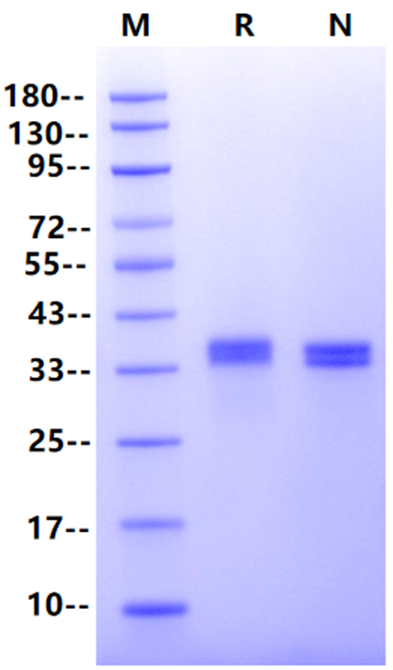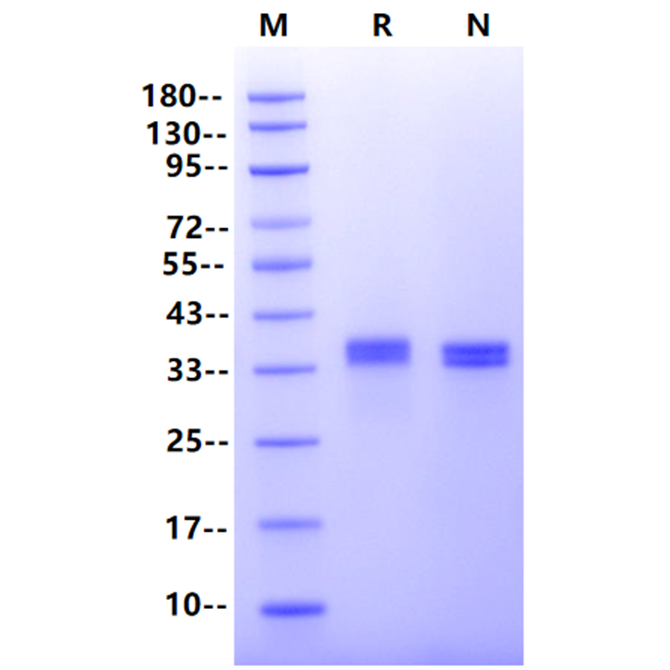Product Details
Product Details
Product Specification
| Species | Mouse |
| Synonyms | TROP1, EpCAM, TACSTD1, CD326, DIAR5, EGP2, EGP314, EGP40, ESA, HNPCC8, HNPCC-8, KSA, M4S1, MIC18, MK1, GA733-2 |
| Accession | Q99JW5 |
| Amino Acid Sequence | Gln24-Thr266, with C-terminal His |
| Expression System | HEK293 |
| Molecular Weight | 33-38kDa |
| Purity | >95% by SDS-PAGE |
| Endotoxin | <0.1EU/μg |
| Conjugation | Unconjugated |
| Tag | His Tag |
| Physical Appearance | Lyophilized Powder |
| Storage Buffer | PBS, pH7.4 |
| Reconstitution | Reconstitute at 0.1-1 mg/ml according to the size in ultrapure water after rapid centrifugation. |
| Stability & Storage | · 12 months from date of receipt, lyophilized powder stored at -20 to -80℃. · 3 months, -20 to -80℃ under sterile conditions after reconstitution. · 1 week, 2 to 8℃ under sterile conditions after reconstitution. · Please avoid repeated freeze-thaw cycles. |
| Reference |
1、Brunner A. et al. (2008) EpCAM is predominantly expressed in high grade and advanced stage urothelial carcinoma of the bladder. J Clin Pathol. 61(3):307-310. 2、Trzpis M. et al. (2008) EpCAM in morphogenesis. Front Biosci. 13: 5050-5055. 3、Munz M. et al. (2009) The emerging role of EpCAM in cancer and stem cell signaling. Cancer Res. 69(14): 5627-5629. 4、Carpenter G. et al. (2009) EpCAM: another surface-to-nucleus missile. Cancer Cell. 15(3): 165-166. |
Background
Epithelial Cellular Adhesion Molecule (EpCAM), also known as KS1/4, gp40, GA733-2, 17-1A, and TROP‑1, is a 40 kDa transmembrane glycoprotein that consists of a 242 amino acid (aa) extracellular domain with two EGF‑like repeats, a 23 aa transmembrane segment, and a 26 aa cytoplasmic domain. It modulates cell adhesion and proliferation. Its overexpression has been detected in many epithelial tumours and has been associated with high stage, high grade and a worse survival in some tumour types. EpCAM has been shown to function as a calcium-independent homophilic cell adhesion molecule that does not exhibit any obvious relationship to the four known cell adhesion molecule superfamilies. However, recent insights have revealed that EpCAM participates in not only cell adhesion, but also in proliferation, migration and differentiation of cells. In addition, recent study revealed that EpCAM is the Wnt-beta-catenin signaling target gene and may be used to facilitate prognosis. It has oncogenic potential and is activated by release of its intracellular domain, which can signal into the cell nucleus by engagement of elements of the wnt pathway.
Picture
Picture
SDS-PAGE

1μg (R: reducing conditions, N: non-reducing conditions).


